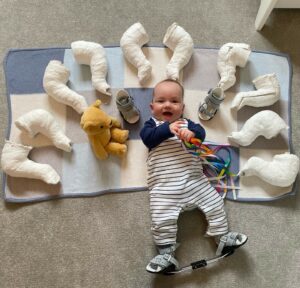We found out that Oakley had bilateral CTEV at our 20 week scan. I didn’t know much about talipes and my husband had never heard of it before. My husband worried that it meant that Oakley may never walk. The STEPS website was recommended to us by our local hospital for us to learn more about it. Oakley is now 6 months old and has recently gone into part time wear of his boots and bar, after 4 weeks of casting (including slipped casts, due to atypical clubfoot), bilateral tenotomy, a further 2 weeks of casting and 12 weeks of full time wear of his boots and bar. After a tough few weeks in cast, an emotional operation and a very difficult first few weeks in boots and bar, Oakley did so well throughout the rest of his treatment and is Mummy and Daddy’s hero. He is so happy to be able to kick around throughout the day now. We decided to take part in the 1000 foot challenge, by walking 100000 feet over the month of June, to raise a little awareness and money for the charity, in the hope to help to support other families too.
We are extremely grateful to Bethany, Dan and Oakley for raising an amazing GBP 500 for families and children impacted by CTEV, commonly known as talipes or clubfoot. If you would like to take part in the #1000FootChallenge #1000MileChallenge then click on Clubfoot Awareness Month – STEPS Charity (stepsworldwide.org)


Clubfoot can be detected during routine pregnancy scans, although it is not possible to determine the severity of the condition at this stage. If not picked up prenatally, clubfoot will be detected at birth as the feet are visibly turned inwards. Treatment is the same regardless of when the condition is detected.
Clubfoot can be classified into 4 categories:
Congenital clubfoot is by far the most common, and most affected children have no other conditions. It is sometimes referred to as isolated clubfoot or idiopathic (meaning cause unknown) clubfoot. Idiopathic clubfoot occurs in about 1 to 2 per 1000 live births.
Positional clubfoot occurs when an otherwise normal foot is held in an incorrect position in the womb. The foot is flexible rather than rigid and can be manipulated into a neutral position easily by hand. Physiotherapy usually corrects this type of clubfoot.
Complex or Atypical clubfoot refers to feet which are more resistant to routine treatment but are still correctable, using a slightly different casting technique. Atypical feet are short and chubby with a deep crease across the sole. The big toe may also stick up at an odd angle to the other toes.
To find out more about CTEV please go to Talipes / Clubfoot – STEPS Charity (stepsworldwide.org)
